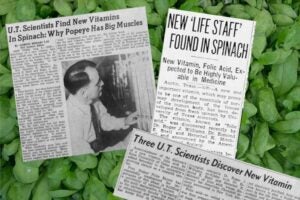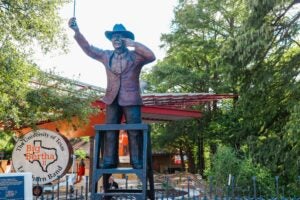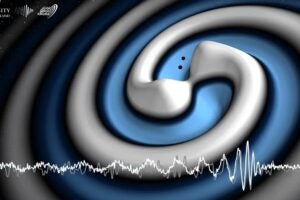AUSTIN, Texas — Living systems can be used to produce microscopically small components of uniform size that potentially can be used to build electronic devices, according to researchers at The University of Texas at Austin. Their discoveries have been published in the June 8 issue of the journal Nature.
By combining proteins from viruses with inorganic elements commonly used as semiconductors, the UT Austin research team produced hybrid materials called electronic biocomposite materials. Biocomposite materials exist in nature in the form of such substances as shell and bone.
By extending the processes that result in naturally occurring biocomposites to substances commonly used in construction of electronic components, the scientists said they are paving the way for development of a host of technological marvels — potential building blocks for transistors, wires, connectors, sensors and computer chips far smaller than anything manufactured so far.
“Nature has amazing control over forming materials like shells and bones, but never ‘moved on’ to electronically important materials like semiconductors,” said Dr. Angela M. Belcher, of UT Austin’s department of chemistry and biochemistry and the UT Austin Texas Materials Institute. Belcher, the lead author of the research paper, explained that “in my group, we focus where nature left off. We are learning from nature, learning how nature makes materials and applying this to other systems.”
In the electronics industry, smaller means faster, cheaper and more convenient, but experts say the industry is reaching the limits of miniaturization. That’s why the field of nanotechnology has been declared a national research priority by the federal government. Nanotechnology is derived from nanos, the Greek word for dwarf, and refers to construction of highly miniaturized devices.
The UT Austin team includes Belcher, an assistant professor in the department of chemistry and biochemistry; Sandra R. Whaley, a graduate student in the department who, with Belcher, also is a lead author; Dr. Paul F. Barbara, who holds the Richard J.V. Johnson-Welch Regents Chair in chemistry; and Dr. Douglas S. English, a postdoctoral fellow in the department of chemistry and biochemistry.
Dr. Evelyn L. Hu, a professor of electrical engineering at the University of California-Santa Barbara (UCSB), participated in the study.
Belcher’s research group is among a handful of scientists nationwide who have been engaged in cutting-edge, multi-disciplinary research that involves binding living materials — proteins from bacteria, viruses, even DNA strands — to semiconductor and metal particles.
Belcher and her graduate student, Sandra Whaley have been isolating viruses containing proteins that can recognize and combine with gallium arsenide, silicon, indium phosphides and zinc selenide. Belcher and her students have identified proteins at the ends of viruses that can tell the difference between similar semiconductor alloys and bind to the ones the scientists prefer.
“We are the only group using this approach,” said Belcher, a materials chemist with expertise in the fields of biomaterials, biomolecular materials, organic-inorganic connections and solid-state chemistry.
When the living proteins bind to the inorganic particles chosen by the scientists, the particles eventually will be “assembled” by the proteins into desired patterns. In effect, the living organisms “grow” uniform components so tiny scientists must use atomic force and electron microscopes to see them. Belcher said a rough comparison could be made to a car putting itself together on an assembly line, although she said the assembly line process is primitive in comparison with the precision that the viruses can achieve. “A lot of organisms can make materials better than we can manufacture them,” she said.
Belcher said any commercialization of products resulting from her research would be some years away. The next research step will be working with the materials to try to integrate them into electronic devices.
The new field of biocomposites appears to overturn some of the basic concepts most people have about a natural world divided among animals, vegetables and minerals. Actually, the dividing lines between what is considered biological and what is considered mineral always have been fuzzier than is commonly assumed.
“Biocomposite materials have been in existence for millions of years. We, ourselves, are biocomposite materials,” said Belcher.
All mammals produce tough, flexible bone and cartilage. Slimy, non-vertebrate sea creatures surround themselves with protective shells. Whales have mouths full of baleen, strongly resembling plastic and once used for “whalebone” corsets. Human bodies contain bones, teeth, fingernails and hair that are not, strictly speaking, biological in origin.
Belcher did her Ph.D. work on seashells, finding that a shell, which is 98 percent inorganic and 2 percent protein, is an excellent example of the link between inorganic and biological materials.
Realizing that sea creatures have “perfect control” over the growth patterns of their shells, she thought: “Wouldn’t it be great to have that kind of control over the kinds of materials that nature hasn’t worked with?”
Belcher said her researchers went through 100 million viruses before slowly determining which ones worked best with certain materials. She said various virus and semiconductor combinations were tried. Only proteins that bound themselves tightly to the semiconductor survived the experiment and were cloned by Whaley.
“Viruses were chosen by whatever material they naturally ‘stuck’ to the best and, consequently, only tend to ‘stick’ to that particular material,” Belcher explained. Still, she said, the process was something akin to having scientists round up 100 million people, all with different house keys, and trying to get them to unlock the same door until the right key was found.
“We used evolutionary tools to select proteins that can control these technologically important materials, with the goal of building next-generation devices,” she said.
Belcher grew up in San Antonio and was graduated from the University of California-Santa Barbara 10 years ago with a degree in creative studies, emphasizing biochemistry and molecular biology. She earned her Ph.D. in chemistry doing interdisciplinary research on organic and inorganic interfaces (connections) and biomaterials. Belcher switched to postdoctoral research in UCSB’s department of electrical and computer engineering and The Center for Quantized Electronic Structures.
Belcher’s work cuts across the fields of inorganic chemistry, materials chemistry, molecular biology and electrical engineering. “We are a multi-disciplinary lab. We do it all,” she said. “This project would not have worked without the ability to use all three approaches. I would not have been able to come up with this idea had I not studied in all these fields.”
The work of the UT Austin research team was supported by a Du Pont Young Investigator Award presented to Belcher; a grant from the Army Research Office of the Defense Advanced Research Projects Agency; the National Science Foundation; the Robert A. Welch Foundation and faculty start-up funds provided the UT Austin. The research took place primarily at UT Austin’s department of chemistry and biochemistry and the Texas Materials Institute.
Some of Belcher’s recent awards include the 2000 Beckman Young Investigator Award, the 1999 Du Pont Young Investigator Award, the 1999 Army Research Office Young Investigators Award, the 1997 Outstanding Graduate Student Award in Chemistry given by the University of California, and the 1996 Outstanding Chemistry Graduate Student Award given by the American Institute of Chemists.
NOTE: For more information, contact Dr. Angela Belcher (512) 471-1154. For information on photos and images, please contact Marsha Miller at (512) 471-3151 or see:
For the Nature Website, see: http://www.nature.com/nature/.



